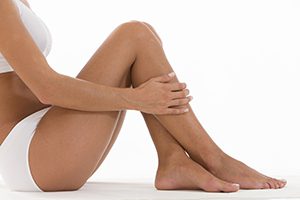As the number of weight loss surgery successes grows , body lift and other post-bariatric plastic surgery procedures are becoming increasingly popular. Our plastic surgeon, Dr. Charles Perry, is experienced in belt lipectomy (central and lower body lift) as well as less extensive post–weight loss plastic surgery such as upper arm lift, tummy tuck, and liposuction. Read more about the body contouring procedures we offer below or contact Chrysalis Cosmetics to schedule your consultation.
- Post-Bariatric Plastic Surgery
- Central and Lower Body Lift
- Body Lift Candidates
- Body Lift Procedure
- Body Lift Considerations
- Body Lift Risks
- Pre- and Post-Op Instructions
Post-Bariatric Plastic Surgery
Central and Lower Body Lift (Belt Lipectomy)
Excess skin that affects the trunk (stomach, hips, and back) or lower body (trunk as well as the thighs and buttocks) can be addressed with a central and/or lower body lift. This multi-modality procedure removes excess skin and contours the body for an improved appearance.
Learn more about Central and Lower Body Lift.
Arm Lift Surgery (Brachioplasty)
Weight loss, the natural aging process, and genetic influences can cause the skin on the upper arms to lose elasticity and begin to sag. Arm lift surgery can reduce excess skin and fatty tissue in this area while providing a slimmer, smoother, and more toned-looking result.
Learn more about Arm Lift.
Thigh Lift Surgery
Sagging skin on the thighs can cause patients to feel self-conscious while obstructing the shape of this feature, but thigh lift surgery can remove the unwanted loose skin and provide an improved contour to the legs. This procedure can also be combined with liposuction for more comprehensive benefits.
Learn more about Thigh Lift.
Brow Lift (Forehead Lift)
Weight loss can lead to changes in skin elasticity on the face as well as the body. Brow lift surgery can elevate the tissues on the forehead to a higher, more youthful level and eliminate excess skin and deep wrinkles.
Learn more about Brow Lift.
Traditional and Mini Facelift
The appearance and contour of the face also can be affected by weight loss. Facelift surgery can help improve concerns related to skin laxity and deep creases on the neck, jawline, and mid-facial region.
Learn more about Facelift.
Eyelid Surgery (Blepharoplasty)
Loose eyelid skin can make you appear tired or older than your age. This issue can even lead to obstructed vision in some people. Eyelid surgery removes excess skin and other common signs of aging on the upper or lower eyelids, or both, to help rejuvenate the appearance.
Learn more about Blepharoplasty.
Breast Augmentation
Enhance breast size, shape, and symmetry with breast augmentation. Dr. Perry uses the most advanced selection of breast implant models and surgical techniques available to achieve natural-looking and feeling results.
Learn more about Breast Augmentation.
Breast Lift
Changes in weight can affect the breasts as much or even more so than other areas of the body. Breast lift surgery with or without implants can be used to restore a more youthful shape to the breasts after weight loss, pregnancy, or the natural process of aging.
Learn more about Breast Lift.
Buttock Enhancement with Brazilian Butt Lift
Buttock enhancement is designed to enhance the size, shape, and contour of the derriere. This procedure may involve fat grafting, liposuction, and other techniques to ensure the optimal outcome.
Learn more about Brazilian Butt Lift.
Central and Lower Body Lift (Belt Lipectomy)
 Significant weight loss, as well as aging, can lead to an excess of skin and fatty tissue that obscures the true shape of the lower trunk. When the excess skin is problematic in a number of areas on the body such as the abdomen, hips, back, buttocks, and outer thighs, a more extensive procedure called lower body lift is needed. This procedure can be called a belt lipectomy, or a central and lower body lift, and is the most well-known type of post-bariatric plastic surgery. At our practice, we are proud to offer this procedure. *Body lift surgery generally enhances self-confidence and physical comfort, while improving the patients overall body image.
Significant weight loss, as well as aging, can lead to an excess of skin and fatty tissue that obscures the true shape of the lower trunk. When the excess skin is problematic in a number of areas on the body such as the abdomen, hips, back, buttocks, and outer thighs, a more extensive procedure called lower body lift is needed. This procedure can be called a belt lipectomy, or a central and lower body lift, and is the most well-known type of post-bariatric plastic surgery. At our practice, we are proud to offer this procedure. *Body lift surgery generally enhances self-confidence and physical comfort, while improving the patients overall body image.
Body lift combines a variety of contouring procedures including thigh lift, tummy tuck, buttocks lift, liposuction, and sometimes others. Because body lift surgery is an extensive undertaking, it is sometimes performed in stages. Post-bariatric plastic surgery is highly individualized and is customized according to the patient’s needs. During your body lift consultation at our practice you will learn more about which approach and combination of procedures will work best for you.
The effects of aging or weight loss are not limited to the lower body or mid-section; these factors can also lead to excess skin drooping from the upper arm. A body contouring procedure called brachioplasty (arm lift) can remedy this condition, and may also be combined with other post-bariatric plastic surgery procedures, to achieve comprehensive figure refinement.
Central and lower body lift, and post-bariatric surgery in general, should not be confused with a weight-loss method. Rather, the procedure should be performed to address significant flaps of skin remaining as a result of weight loss or aging.
*Individual Results May Vary
Candidates for Body Lift
Those considering a central and lower body lift should remember that this is an extensive surgery. Body lift surgery can help patients of all ages, though patients must be mentally fit and prepared to handle a long and painful recovery period. To ensure safety, some patients are required to attend counseling or undergo psychiatric drug therapy previous to undergoing body lift surgery.
Post-bariatric plastic surgery is not recommended for:
- Morbidly obese individuals
- Smokers – Nicotine use makes body lift surgery unacceptably risky.
- Individuals with medical problems – Medical conditions barring patients from receiving general anesthetic will disqualify patients for the surgery.
- Individuals planning to lose more weight – Further weight loss will cause skin to slacken, negate the skin-tightening results of the surgery.
How is the body lift surgery performed?
 The exact sequence of the procedures performed during central and lower body lift surgery is highly dependent on the needs of the patient. However, typically the abdomen is addressed first. Just as in tummy tuck surgery, excess skin is removed from around the midsection, the abdominal muscles are tightened, and areas of remaining fat are sculpted with liposuction. During this time, the belly button remains connected to the underlying tissue, and once the appropriate amount of fat is removed, the skin above the belly button is smoothed down, drawn taut and sutured into place, allowing the belly button to be brought through a new opening. Multiple drains are placed to prevent fluid accumulation under the skin before the incision is secured.
The exact sequence of the procedures performed during central and lower body lift surgery is highly dependent on the needs of the patient. However, typically the abdomen is addressed first. Just as in tummy tuck surgery, excess skin is removed from around the midsection, the abdominal muscles are tightened, and areas of remaining fat are sculpted with liposuction. During this time, the belly button remains connected to the underlying tissue, and once the appropriate amount of fat is removed, the skin above the belly button is smoothed down, drawn taut and sutured into place, allowing the belly button to be brought through a new opening. Multiple drains are placed to prevent fluid accumulation under the skin before the incision is secured.
In the next stage of body lift surgery, the patient is turned on his or her side as the back and outer thigh area is addressed. Skin flaps and excess fat are removed from around the back area, and stubborn fatty deposits are removed to resculpt the outer thighs. Subsequent to the removal of skin and fat from the back, the buttocks are lifted and the incisions are sutured closed, which tightens and smoothes the appearance of the entire lower body, eliminating the appearance of sagging skin.
Central and lower body lift is a highly customizable surgery. Each procedure described above is performed to varying degrees, depending on the patient’s unique needs. In some cases, the procedures that comprise body lift surgery (tummy tuck, thigh lift, buttock lift, liposuction, and sometimes an upper arm lift) are done at once.
In total, body lift usually takes six to 12 hours to complete. This type of post-bariatric plastic surgery is nearly always completed while the patient is under general anesthesia, and afterward, an overnight stay in the hospital is often recommended.
Things to Consider Before Undergoing Body Lift Surgery
Patients thinking of undergoing central and lower body lift surgery should consider the following:
Body lift surgery should not replace weight loss
Rather, body lift is best utilized to refine the results of significant weight loss, which can leave lax skin drooping from a person’s frame.
Maintain weight stability
You must have maintained a stable weight for three to six months to be a good candidate for body lift. The amount of time required varies according to a variety of factors. Talk to Dr. Perry for details.
Further weigh loss negates results
If you lose weight after body lift surgery, more loose skin will appear. That is why patients of a stable weight who do not plan to lose more weight are the only acceptable candidates for body lift surgery.
Discomfort and duration of recovery
It will take at least three weeks to get back to normal after body lift surgery, so you must plan ahead. You must also be mentally prepared for discomfort during recovery and scars left after the surgery.
Financial responsibilities
Body lift surgery is done on a fee-for-service basis, which means it is not covered by health insurance. Your total surgical fee will include the cost of surgical supplies, anesthesia, laboratory tests, medications, surgery center charges, and possibly more. If you experience complications, you will incur additional expenses. However, if the complication is considered a health risk, your health plan will cover the cost of hospitalization, anesthesia, and/or additional surgery.
Risks of Body Lift Surgery
Because central and lower body lift surgery is such an extensive surgery often involving several procedures, there are many potential complications patients must be aware of. Knowing these risks will help you decide whether surgery is right for you. The following is only a partial list of complications; you will discuss the risks in further detail with Dr. Perry during your pre-surgery consultations.
General surgical risks
These include heart attacks, infection, bleeding, injury to surrounding structures, and reactions to anesthesia.
Bleeding and seroma (fluid accumulation)
A bleeding episode can occur anytime during or after surgery and may require a trip to the hospital. In addition, seroma (fluid accumulation) can occur, despite the placement of surgical drains. Any fluid accumulation is usually treated with repeated needle aspirations.
Deep vein thrombosis (blood clot formation in the legs)
Blood clots are a dangerous complication that can lead to pulmonary embolus (blockage of an artery in the lungs). Every effort is made to prevent its occurrence, including making sure the patient walks as soon as possible after body lift surgery.
Wound separation
While wound separation cannot be predicted, carefully following post-operative guidelines is the best way to avoid this complication.
Difficult healing
About half of patients experience some difficulty with healing, which is painful and may require further treatment by Dr. Perry.
Recurrence of loose skin
It is possible that folds of loose skin can reappear after body lift surgery as the skin naturally relaxes.
Asymmetry
The results of body lift surgery may appear asymmetrical. Further surgery may be helpful in improving symmetry, or the patient may choose to live with the result.
Need for revisional surgery
Recurrence of loose skin, asymmetry, or another factor may create a need for a revisional procedure. The cost for revisional surgery is not included in your initial fees.
Complete Pre- and Post-operative Instructions for Body Lift Patients
Following body lift surgery, you will be required to stay one or two nights in the hospital. For one or two weeks, you will have several drains in place that collect fluid and blood from under the skin. In the first few days after the surgery, you will gradually be able to stand and walk again. For a week or so, it may help to walk in a slightly bent position.
Post-bariatric plastic surgery has a relatively long recovery period. It will take four to six weeks to return to your daily routine.
For comprehensive pre- and post-surgery instructions, refer to the link below. We recommend you review the instructions well before body lift surgery, print them out, and bring them with you on your surgery day.
Body Lift Instructions (printer-friendly)
Please contact Chrysalis Cosmetics today to learn more about body lift surgery, or to schedule your consultation.


